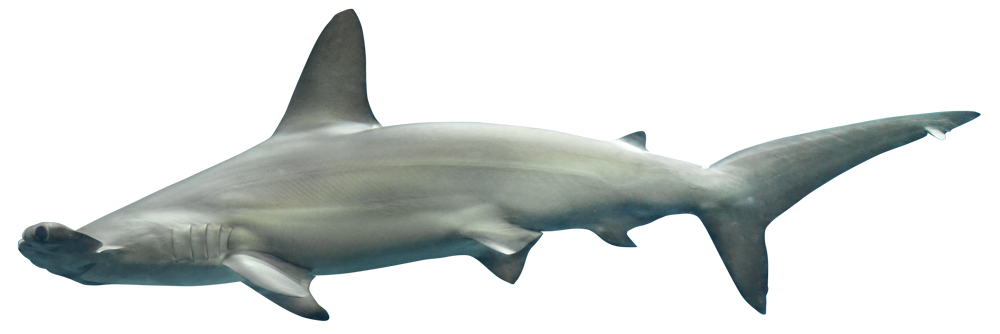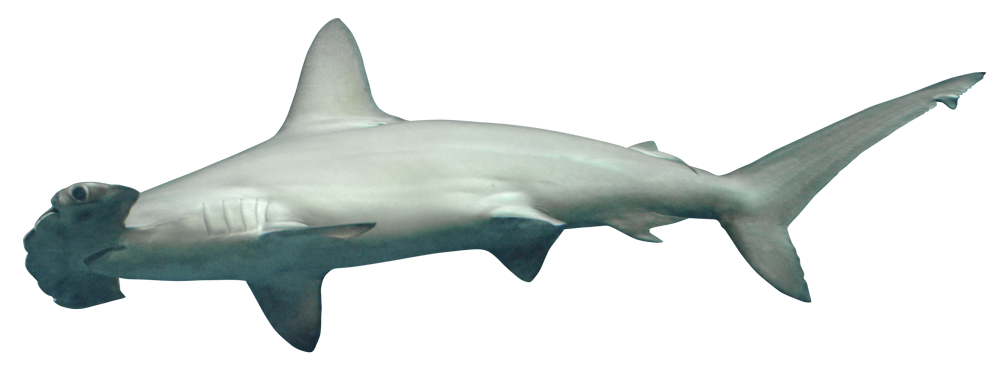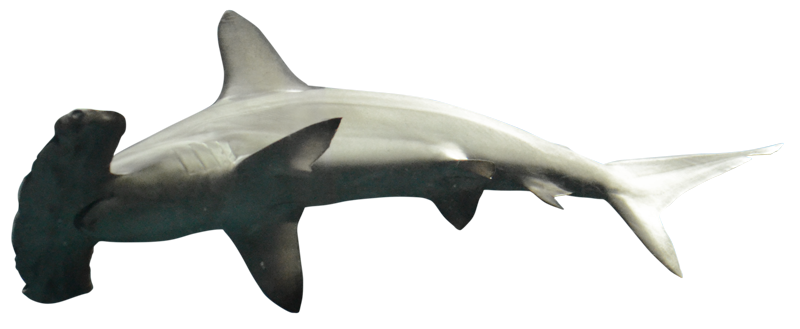
Sphyrna lewini (Griffith & Smith, 1834)
T型頭部の秘密
The Secret of the T-Shaped Head
体長は1.5~2.5mで、最大で4mに達することもあります。熱帯域から温帯域の沿岸部に広く生息しています。和名の漢字表記は「赤撞木鮫」です。「撞木(しゅもく)」とは、仏教用語で鐘を打ち鳴らすT字型の棒を指します。体表は赤くありませんが、肉の色が赤身であることからこの名が付きました。なお、シロシュモクザメも同様に、肉の色が白いことが名前の由来です。
シュモクザメ属は全9種に分類されます。特徴的なT字型の頭部は、左右の視界を大きく広げる形状で、垂直面360°の広い視角を持っています。特にアカシュモクザメは頭部が左右に長く、左右の視界は約32°重なっています。この重なりにより立体視が可能となり、素早く動く獲物を捕らえるのに役立つと考えられます。一方で正面の視野は死角となりますが、T字型の頭部は上下の視野に特化した進化形態とも言えます。
一般にサメは単独で行動することが多いとされていますが、シュモクザメは日中に100匹以上の群れを作ることもあります。その理由はまだ明らかになっていません。繁殖は胎生で、卵を産まずに幼魚を完全に成長した状態(40~50cm)で出産します。幼魚は生まれてすぐ自分で餌を捕り、活発に泳ぎ回ります。餌は魚類や甲殻類、イカやタコなどの頭足類で、特にアカエイを好んで捕食し、その毒針もものともしないようです。
The great hammerhead shark reaches a length of 1.5–2.5 m, with some individuals growing up to 4 m. It inhabits coastal waters widely, from tropical to temperate regions. Its Japanese name means “red hammer shark”. The term shumoku refers to a T-shaped wooden mallet used in Buddhist rituals to strike bells. Although its body is not red, the name comes from the red hue of its flesh. Similarly, the white hammerhead (Shiro-shumoku-zame) is named for the white color of its meat.
The hammerhead shark genus includes nine species. The T-shaped head significantly broadens their lateral vision, providing nearly 360° of vertical visual coverage. In the great hammerhead, the head is particularly wide, resulting in approximately 32° of overlapping visual field on each side. This overlap allows for stereoscopic vision, which is thought to help them capture fast-moving prey. However, this adaptation creates a blind spot directly in front of them, suggesting that the T-shaped head is specialized for enhanced vertical vision.
While most sharks are known to be solitary, hammerhead sharks can form schools of over 100 individuals during the day. The reason for this behavior remains unclear. Reproduction is viviparous: they give birth to fully developed young measuring 40–50 cm, rather than laying eggs. Newborns immediately learn to hunt for themselves and swim actively. Their diet includes various fish, crustaceans, and cephalopods such as squid and octopus. They particularly favor red stingrays, seemingly unaffected by their venomous spines.
参考文献
東京都島しょ農林水産総合センター | 伊豆・小笠原諸島の魚 | アカシュモクザメ 2025年1月11日閲覧
Bourton, Jody (2009, November 27) “Hammerhead shark mystery solved” BBS earth news. 2025年1月11日閲覧
ナショナルジオグラフィック | ニュース | シュモクザメの立体視覚は人間並み | (2009年11月27日) 2025年1月11日閲覧
Chappell, Emily (2024, April 8) “Top Ten Hammerhead Shark Facts” Original diving. 2025年1月11日閲覧
東京ズーネット | ニュース | 大小にぎわうサメ水槽 | (2018年6月22日) 2025年1月11日閲覧

